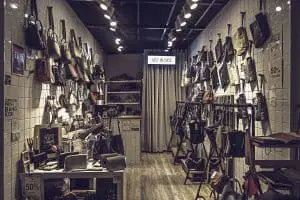Introduction
With digital technologies providing new and exciting business models in fashion, the industry is experiencing an unprecedented level of competition as customers are starting to change their behaviours, due to the high saturation that marketing communications have reached. Making your brand stand out in such a competitive marketplace is a real challenge, and many new entrants can fear that not much can be done to move past the noise.
Before we give us hope, we need to remember that with so much happening in the fashion industry and it’s never too late to start a brand and build a business. In this post, we’re going to look into what fashion brands should be doing to make sure they succeed by focusing on what matters. When so many different approaches are possible, we need to “double down” on what makes a difference for our customer.
In this article, we’re going to approach this broad topic by focusing on 3 key areas. First, we’ll address three key areas of innovation for brand development, to help you understand what are some elements that customers demand from your fashion company. We’ll then move on beyond the “brand blueprint” to evaluate three different engagement strategies that are “a must” for any organisation wishing to move past the noise. Lastly, we’ll look at some of the new trends that we may take advantage of in order to become early entrants in new market spaces.
To help you navigate this content we’ve broken up the article in the following sections:
- The Challenges of Building a Brand
- How to Build an Engaging Fashion Brand
- Don’t Miss Out on the New Opportunities
- Conclusions: Our 3 Tips to Building a Strong Brand.
1. The Challenges of Building a Brand
The Challenge of Gaining Consumer Attention. This is the first challenge for any brand, big or small, new or old. Let’s see how this issue can be tackled.
Undeniably, developing a brand is a big effort for any organisation, and it’s a primary goal of any business wishing to compete in the fashion industry. The primary ingredient to achieving this goal is your audience’s attention. That might sound obvious, but gaining attention is everyone’s business at the moment as all businesses are adopting strategies designed to attract customers to their platform through TOFU (top of the funnel marketing) much before they might actually have anything to sell them.
- The inbound marketing approach. This approach is based on inbound marketing or an approach to marketing which essentially allows companies to create and seed content online (and offline) with the intent of developing brand awareness. This strategy is the “great equaliser” as the web allows any organisation, big or small, to build a strong digital presence and attract visitors, and because of how inexpensive these strategies can be (sometimes all it takes is to build a blog) everyone is doing it.
- The old ‘outbound’ marketing strategy. If inbound marketing poses challenges connected to market saturation, we need to remind ourselves that outbound marketing was still much worse. The approach of outbound marketing consisted of a simple strategy “He Who Shouts Loudest Wins”. In this context, it’s clear how this is another way to say “He Who Has the Largets Budget Reaches the Largest Audience”. So even if the idea of developing online content can be daunting, we should take into consideration that the alternative might be so much worse especially for small, startup companies who do not necessarily have access to a rich marketing budget.
- The Challenge of Selling Value and Not Simply a Product. The second issue we need to explore is the idea that a brand cannot limit itself to selling simply a product. A product is extremely hard to sell because for any product category there are countless alternatives. A brand needs to be able to infuse into its products something unique that customers can resonate to.
In other words, a product cannot be the end of marketing communication. A product should instead be a gateway to developing a long-term relationship with a brand. This relationship should be based on the celebration of the values that a brand stands by.
We always need to remember that customers buy value, and in order to attract them we need to have a very clear understanding of the type of job our customers need to get done, and how our products are helping them. In this sense, as marketers, we need to start leaving the personas framework at the door and start working with the Jobs to Be Done Framework. If you’re interested in reading more about this marketing strategy, here’s a link to another resource from our blog entitled “Why Jobs to Be Done Theory Matters for Your Business”.
Remember also, that value cannot be simply sold, but co-created. The biggest value contribution you can give your audience is if your brand builds value with the participation of your customers. Think about Patagonia, for instance, and how this brand was able to pursue a very strong stance on fashion sustainability and developed a customer-oriented service devoted to extending the lifespan of Patagonia garments through repairs. By doing this, not only Patagonia is approaching an environmentally-conscious approach to business but is taking the journey together with its customers. This can be surely seen as a great example of value co-creation.
- Not masses, but individuals, the increasing relevance of personalised experiences.
We tend to often misinterpret what a brand actually is as if a brand is something objective and set in stone. The reality is that for your fashion business organisation there are hundreds or thousands of brands, one per each of your customers.
A brand can be defined as the “gut feeling” that you are able to ignite in your customer when your company is mentioned. Each person will have a particular reaction, as each person will process the brand according to a different set of values, criteria etc. If you’re interested in reading about the theoretical frameworks that marketers apply to brand management, in this article we address the topic in greater depth.
As a result, brands need to understand how to leverage their customer relationships on the grounds of personalised experiences. To this end, mobile technologies can really help us interact with our customer as if the brand was speaking to each one individually. This is why the keyword for branding in 2021 is still the same: engagement. This term can mean different things, let’s see how can a brand actually become engaging. We’ll address this topic in the following section of our article.
2. How To Build An Engaging Fashion Brand
Sometimes when we talk about building a brand, it can seem that a brand strategy is comprised of a series of tasks that we need to perform. This is not the right approach to brand development, actually, this is the opposite of a strategy. A strategy is like a policy, it’s a rule that allows you to identify what you should or should not do. Because our resources are limited it’s necessary to understand what we can do and what is out of our reach. In this section of the article, we are going to help you focus on what needs to get done using the 8020 rule, making sure that you spend most of your time on what actually matters the most.
- Focus on the most profitable customers. Not all customers are the same, as we know in business, it’s much cheaper to retain a customer, rather than acquiring a new one. In this sense, we can immediately see how our focus should be on retention, not as much on customer acquisition. Making sure that you develop a strong bond with your existing customers will not only make your business more stable but also help you develop a strong word-of-mouth marketing. Word of mouth is actually an important element to take into account, and in this post, we discuss it at length as it’s a very important form of marketing.
- Don’t miss out on new customers. Having said, that existing customers require some special attention, we cannot downplay the fact that acquiring new ones is important too. We need to remember that the process of acquisition is a fairly long one, it can take up to 6 or 7 interactions between our brand and a potential client before he or she may convert into a buyer. This means that we need to spend some time doing our top-of-the-funnel marketing so that we can start building on those spontaneous interactions that can help us convert in the long run.
- Take advantage of customer recommendations. As we juggle between old and new clients, let’s remember that shopping is social! On average as much as 50% of our shopping decisions are influenced by recommendations. This is why we need to stay social and use the peer-to-peer recommendation tools that digital marketing provides. Let’s make sure we take full advantage of influencers, that we keep in check our online reputation, that we respond to social media comments – especially the negative ones – to show that we can stand the heat of social media presence and we can manage our customers effectively.
- Use User-Generated Content. As you build your social presence, remember that advertising works, but up to a point. Social surfers are flooded by “staged” pictures and rehearsed videos. You need to be more spontaneous, and you need to celebrate your users. Instead of spending thousands of euros in photo shootings and advertising campaigns, focus on your customers and cherish them by sharing their content. UGC is one of the most effective social media materials, as it not only interesting to see, it’s strong market validation.
Let’s now move on a more outward perspective, one that takes into account the innovations in the industry.
3. Don’t Miss Out on the New Opportunities
Ok, now that we’ve covered the basics, let’s look into something else. Let’s see what you can do to explore new market opportunities, to gain an edge on your competition.
- Explore New Platforms. It’s common to crowd the same online spaces because that’s where everyone is. At the same time, getting noticed in a crowd is a huge cost. What if instead, you could be an early entrant in a new platform? This will allow you to build a following early, and cheap.
- Identify New Entrants Early. Take a look at your competition, some of the new entrants could have some ideas worth trying. In fashion, heritage brands are market leaders, but every now and then, someone comes along and revolutionises the industry. Get inspired to try out new things, and look out for the small companies that can make it big.
- Explore alternative business models. Always question if “the way things are done” is the best way to do things. Customers change, and businesses should too, taking a long hard look at you business model can really help you figure out if there are opportunities to make your business more efficient, more valuable, more relevant.
We should always act as if we’re in a crisis because in business the next challenge is always around the corner. Make sure you’re looking into new opportunities, as a window to pivot and revolutionise your brand is always open. Let’s now move on and wrap up the topic in the conclusions of the article.
4. Conclusions: Our 3 Tips for Building A Strong Brand
Building a brand is challenging, and requires determination and hard work. What we want to share with this article is that strong brands are not only for large businesses, even smaller fashion firms can develop high brand equity and build a loyal audience. As you approach this challenge remember three things.
- Everyone is fighting for customer’s attention. This is also why in fashion, like in many other industries, all companies are media companies. As you set out to develop a brand, work on your inbound marketing strategies, and create content that delivers the values associated with your brand. Remember that your product is not the end of the transaction, it’s actually the beginning of a long-term relationship. As for any other relationship, the one between a brand and a customer is unique, you should consider each customer individually and provide, as much as possible, a personalised brand experience.
- Not all customers are the same. When building a brand it’s easy to work on the idea of “the more the merrier” but in reality, this approach is not only wrong, its unprofitable. 80% of your revenue will come from 20% of your customers, therefore established customers are much more important than new clients. Make sure you look after the customers you already have, before investing too much time and money on new ones.
- Always be on the lookout. As you build your brand, it’s easy to follow established brands who may have some interesting best practices to apply. On the other hand, always scan the market for firms that are doing things a little bit different, as they may be spearheading new approaches that will soon become the norm.
We hope that this article helps you focus on your brand strategy, and don’t hesitate to browse our blog for more articles on fashion marketing.
If you’re interested in learning more about the Fashion Industry, don’t hesitate to take a look at our course “The Fashion Industry: Explained”. Our in-depth class covers a wide range of topics spanning from understanding fashion customers and markets to developing immersive retail experiences for your customers. Here’s a link to the course, if you use the discount code BLOG20 you can access a 20% discount. Enjoy!







